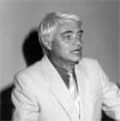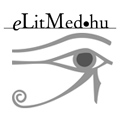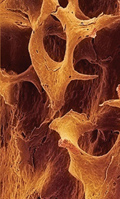The eLitMed.hu medical portal uses computer cookies for convenient operation. Detailed information can be found in the Cookie-policy.
Ca&Bone - 2004;7(02)
Content
[The role and effects of progestogens in menopausal hormone therapy]
[The adequate therapy of postmenopausal hormone deficiency is estrogen replacement. However, the risk of endometrium hyperplasia and carcinoma is significantly increased among users of estrogen as monotherapy.To minimize the risk of endometrial cancer, a progestogen must be added to estrogen therapy. While progestogens may inhibit the cardiovascular effects of estrogens, they do not significantly influence the effects of estrogen on bone. The increased risk of breast cancer among menopausal hormone therapy users seems to be the consequence of progestin administration.There are notable differences among progestins in their effects and side effects, thus, in the future, therapeutic protocols should be tailored individually.The differential effects of various progestogens is an exciting area to study, partly because it may have clinical consequences, partly, because it provides opportunities for far-reaching research.]
[Bone metabolism and body mass index in postmenopausal women]
[INTRODUCTION - In addition to several other causes constitutional factors play an important role in the development of osteoporosis.Various aspects of bone metabolism were examined to explain the differences in bone density between women with low and high body mass index (BMI). PATIENTS AND METHOD - One hundred and ninetytwo postmenopausal women were included in the study. Bone density was measured by forearm densitometry.To assess bone formation, serum osteocalcin levels were measured, while the rate of bone absorption was estimated from C-terminal telopeptide levels of collagen type I measured in urine and blood. RESULTS - The prevalence of osteoporosis was higher in women with low BMI than in those with normal or higher BMI. Bone metabolism - both formation and absorption - was increased in both groups, however, in women with low BMI this increase was more pronounced and bone metabolism tended to be shifted to absorption compared to patients with normal or higher BMI. CONCLUSION - Postmenopausal lean women have accelerated bone metabolism compared to obese women. This fact and the shift to absorption may be the main reasons for the higher frequency of osteoporosis found by densitometry in women with low BMI than in those with higher BMI.]
[Bone mineral density and diabetes mellitus - First results]
[INTRODUCTION - Data on bone mineral density (BMD) in diabetes mellitus are contradictory in the literature. Early studies described a decreased bone mineral density in type 1 diabetes mellitus (T1DM), but recent studies report no osteopenia in T1DM.The BMD may depend on the quality of treatment for diabetes mellitus and on the presence of chronic complications. In type 2 diabetes mellitus (T2DM) the BMD is not decreased, occasionally it can even be increased. PATIENTS AND METHODS - Bone mineral density was measured in 122 regularly controlled diabetic patients (T1DM: n=73, mean age: 43.6±11.1 years,T2DM: n=49, mean age: 61.8±9.8 years) by dual energy X-ray absorptiometry at the lumbar spine and at the femur. Results were compared to those of 40 metabolically healthy control persons with a mean age of 47.5±11.9 years.The patients’ carbohydrate metabolism was assessed by the average HbA1c level of the last three years.These values were 7.9±1.4 % in T1DM, and 7.5±1.7 % in T2DM. BMDs were classified based on the T-score and Z-score using the WHO criteria. RESULTS - There was no significant difference in T1DM or in T2DM compared to the reference group in the prevalence of either osteoporosis or of osteoporosis and osteopenia combined. CONCLUSION - BMD was not found to be decreased in patients with well-controlled metabolism compared to healthy controls.]
[Evaluation of quality of life following treatment with calcitonin nasal spray in patients with osteoporosis: preliminary results of the MERLIN study]
[INTRODUCTION - MERLIN (Management of Osteoporosis in Elderly with Calcitonin) is an open-label, multicenter, prospective, follow-up study conducted in Hungary, part of which is to assess the impact of treatment with Miacalcic, - an intranasal salmon calcitonin, on the quality of life (QoL) among patients with osteoporosis. In this paper we report the preliminary results of the MERLIN study. PATIENTS - The study initially involved 1949 senior patients (aged >65 years) to whom calcitonin was prescribed for osteoporosis according to the application instructions. Patients presented at outpatient clinics and consisted of two groups; they were either newly diagnosed or they had been receiving a therapy for osteoporosis other than calcitonin. METHODS - This latter group discontinued their previous treatment and all patients received 200 IU intranasal salmon calcitonin (SCT) once daily for three months. Patient and physician questionnaires were used to collect information on the patients' QoL (EQ-5D VAS) and their general well-being at baseline and at follow-up visits at week 4 and week 12. RESULTS - Calcitonin use was associated with improvements in all EQ-5D domains and component scores as well as in VAS. Patients with previously known osteoporosis who, switched to calcitonin therapy achieved better results (0,046 QALY), than the newly diagnosed patients (0,0405 QALY). CONCLUSIONS - We conclude that intranasal SCT 200 IU daily is safe and effective in improving QoL of both, male and female patients with low bone mineral density.The conclusions that can be drawn from this study are limited due to the lack of a control group and to the unblinded design. Further placebo-controlled studies are needed to confirm these results. Nevertheless, our study was the first in Hungary to evaluate the quality of life impact of an osteoporosis treatment, and hopefully it will be followed by more such studies directed to other osteoporosis treatments.]
[The role of alfacalcidol in the prevention of osteopenia following renal transplantation]
[AIM - The aim of this prospective study was the long-term evaluation of the effect of calcium and alfacalcidol treatment on calcium metabolism in patients with renal transplantation. METHODS - Patients were divided in two groups. Patients in Group 1 (n=159) received calcium substitution, while patients in Group 2 (n=81) were treated with alfacalcidol. Serum Ca, P, Mg, alkaline phosphatase (AP) and PTH levels were determined before and after transplantation regularly for three years. Femur neck and lumbar vertebral bone mineral densities (BMD) were measured at the same time after transplantation. RESULTS - After transplantation the mean serum calcium level significantly increased, while the mean serum phosphate level significantly decreased in both groups. After the operation the PTH levels decreased in both groups and it was found to be more pronounced in the alfacalcidol group.The majority of patients had osteopenia in the follow-up period. Between the third month and the third year after transplantation, BMD increased by 9.4% in Group1, and decreased by 4% in Group 2 at the lumbar spine. At 3 years the mean BMD value at the femoral neck was increased by 6.5% in Group 1, and by 6.7% in Group 2, compared to the 3-month values.The change in BMD was only significant at the lumbar spine, in Group 1 (p=0.019). During the follow-up period osteonecrosis was diagnosed in 6 patients in Group 1 and in 9 cases in Group 2. CONCLUSION - Alfacalcidol treatment decreased secondary hyperparathyroidism more rapidly and effectively, which was also indicated by the more pronounced decrease of serum PTH levels. During the 3 years follow-up period, BMD increased in both groups except for the lumbar spine in Group 2, however, the majority of the patients still had osteopenia.The study could not demonstrate a superiority of alfacalcidol over calcium supplementation in the prevention of posttransplantational osteopenia.]
1.
Clinical Neuroscience
[Headache registry in Szeged: Experiences regarding to migraine patients]2.
Clinical Neuroscience
[The new target population of stroke awareness campaign: Kindergarten students ]3.
Clinical Neuroscience
Is there any difference in mortality rates of atrial fibrillation detected before or after ischemic stroke?4.
Clinical Neuroscience
Factors influencing the level of stigma in Parkinson’s disease in western Turkey5.
Clinical Neuroscience
[The effects of demographic and clinical factors on the severity of poststroke aphasia]1.
2.
3.
4.
5.









